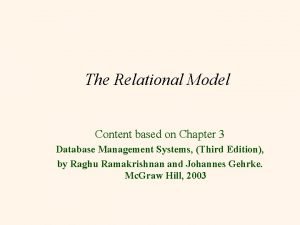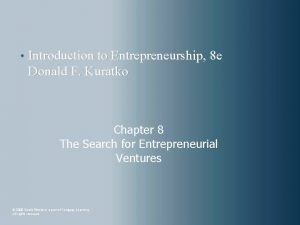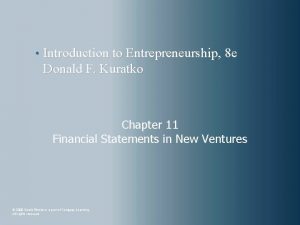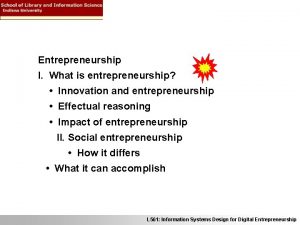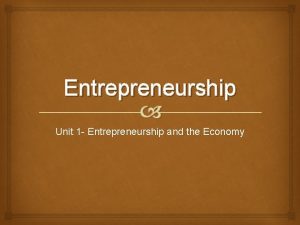Introduction to Entrepreneurship 8 e Donald F Kuratko


















- Slides: 18

Introduction to Entrepreneurship, 8 e Donald F. Kuratko Chapter 2 The Individual Entrepreneurial Mind-Set © 2009 South-Western, a part of Cengage Learning. All rights reserved.

Chapter Objectives 1. To describe the entrepreneurial mind-set. 2. To present the major sources of information useful in profiling the entrepreneurial mind-set 3. To identify and discuss the most commonly cited characteristics found in successful entrepreneurs 4. To discuss the “dark side” of entrepreneurship 5. To identify and describe the different types of risk entrepreneurs face as well as the major causes of stress for these individuals and the ways they can handle stress 6. To examine entrepreneurial motivation © 2009 South-Western, a part of Cengage Learning. All rights reserved. 2– 2

The Entrepreneurial Mindset • Entrepreneurial Mindset Ø Describes the most common characteristics associated with successful entrepreneurs as well as the elements associated with the “dark side” of entrepreneurship. • Who Are Entrepreneurs? Ø Independent individuals, intensely committed and determined to persevere, who work very hard. Ø They are confident optimists who strive for integrity. Ø They burn with the competitive desire to excel and use failure as a learning tool. © 2009 South-Western, a part of Cengage Learning. All rights reserved. 2– 3

Sources of Research on Entrepreneurs Research and Popular Publications Direct Observation Speeches, Seminars and Presentations The Entrepreneurial Mindset © 2009 South-Western, a part of Cengage Learning. All rights reserved. 2– 4

Sources of Research on Entrepreneurs (cont’d) • Publications Ø Technical and professional journals Ø Textbooks on entrepreneurship Ø Books about entrepreneurship Ø Biographies or autobiographies of entrepreneurs Ø Compendiums about entrepreneurs Ø News periodicals Ø Venture periodicals Ø Newsletters Proceedings of conferences © 2009 South-Western, a part of Ø The Internet Cengage Learning. All rights reserved. • Direct Observation of Practicing Entrepreneurs Interviews Ø Surveys Ø Case studies Ø • Speeches, Seminars, and Presentations by Practicing Entrepreneurs Ø 2– 5

Common Characteristics of Entrepreneurs • Commitment, determination, and perseverance • Calculated risk taking • Tolerance for failure • Drive to achieve • High energy level • Opportunity orientation • Creativity and Innovativeness • Initiative and responsibility • Vision • Persistent problem solving • Self-confidence and • Seeking feedback optimism • Internal locus of control • Independence • Tolerance for ambiguity • Team building © 2009 South-Western, a part of Cengage Learning. All rights reserved. 2– 6

Outline of the Entrepreneurial Organization Research by Howard and David Imagination Flexibility © 2009 South-Western, a part of Cengage Learning. All rights reserved. Acceptance of Risks 2– 7

Table 2. 1 Characteristics Often Attributed to Entrepreneurs 1. Confidence 15. Intelligence 29. Pleasant personality 2. Perseverance, determination 16. Orientation to clear goals 30. Egotism 3. Energy, diligence 31. Courage 4. Resourcefulness 17. Positive response to challenges 5. Ability to take calculated risks 6. Dynamism, leadership 7. Optimism 8. Need to achieve 9. Versatility; knowledge of product, market, machinery, technology 10. Creativity 11. Ability to influence others 12. Ability to get along well with people 18. Independence 19. Responsiveness to suggestions and criticism 20. Time competence, efficiency 21. Ability to make decisions quickly 32. Imagination 33. Perceptiveness 34. Toleration of ambiguity 35. Aggressiveness 36. Capacity for enjoyment 37. Efficacy 22. Responsibility 38. Commitment 23. Foresight 39. Ability to trust workers 24. Accuracy, thoroughness 40. Sensitivity to others 25. Cooperativeness 41. Honesty, integrity 26. Profit orientation 42. Maturity, balance 13. Initiative 27. Ability to learn from mistakes 14. Flexibility 28. Sense of power © 2009 South-Western, a part of Cengage Learning. All rights Source: John A. Hornaday, “Research about Living Entrepreneurs, ” in Encyclopedia of Entrepreneurship, ed. Calvin Kent, Donald Sexton, and Karl Vesper, © 1982, 26– 27. Adapted by permission of reserved. Prentice-Hall, Englewood Cliffs, NJ. 2– 8

Entrepreneurship Theory • Entrepreneurs cause entrepreneurship. Ø Entrepreneurship is a function of the entrepreneur: Ø Entrepreneurship is the interaction of skills related to inner control, planning and goal setting, risk taking, innovation, reality perception, use of feedback, decision making, human relations, and independence. © 2009 South-Western, a part of Cengage Learning. All rights reserved. 2– 9

The Entrepreneurial Journey • Entrepreneurs Ø Create ventures much as an artist creates a painting. Ø Are formed by the lived experience of venture creation. • Experiential Nature of Creating a Sustainable Enterprise involves 3 interactive phenomena Emergence of the opportunity Ø Emergence of the venture Ø End emergence of the entrepreneur Ø © 2009 South-Western, a part of Cengage Learning. All rights reserved. 2– 10

The Dark Side of Entrepreneurship • The Entrepreneur’s Confrontation with Risk Ø Financial risk versus profit (return) motive varies in entrepreneurs’ desire for wealth. Ø Career risk—loss of employment security Ø Family and social risk—competing commitments of work and family Ø Psychic risk—psychological impact of failure on the well-being of entrepreneurs © 2009 South-Western, a part of Cengage Learning. All rights reserved. 2– 11

Figure 2. 1 Typology of Entrepreneurial Styles © 2009 South-Western, a part of Cengage Learning. All rights Source: Thomas Monroy and Robert Folger, “A Typology of Entrepreneurial Styles: Beyond Economic Rationality, ” Journal of Private Enterprise IX(2) (1993): 71. reserved. 2– 12

Stress and the Entrepreneur • Entrepreneurial Stress Ø The extent to which entrepreneurs’ work demands and expectations exceed their abilities to perform as venture initiators, they are likely to experience stress. • Causes of Entrepreneurial Stress Ø Loneliness Ø Immersion in business Ø People problems Ø Need to achieve © 2009 South-Western, a part of Cengage Learning. All rights reserved. 2– 13

Entrepreneurs: Type A Personalities • Chronic and severe sense of time urgency. • Constant involvement in multiple projects subject to deadlines. • Neglect of all aspects of life except work. • A tendency to take on excessive responsibility, combined with the feeling that “Only I am capable of taking care of this matter. ” • Explosiveness of speech and a tendency to speak faster than most people. © 2009 South-Western, a part of Cengage Learning. All rights reserved. 2– 14

Dealing with Stress • Networking • Getting away from it all • Communicating with employees • Finding satisfaction outside the company • Delegating • Exercising Rigorously © 2009 South-Western, a part of Cengage Learning. All rights reserved. 2– 15

The Entrepreneurial Ego • Self-Destructive Characteristics Ø Overbearing need for control Ø Sense of distrust Ø Overriding desire for success Ø Unrealistic optimism • Entrepreneurial Motivation Ø The quest for new-venture creation as well as the willingness to sustain that venture. • Personal characteristics, personal environment, business environment, personal goal set (expectations), and the existence of a viable business idea. © 2009 South-Western, a part of Cengage Learning. All rights reserved. 2– 16

Figure 2. 2 A Model of Entrepreneurial Motivation © 2009 South-Western, a part of Source: Douglas W. Learning. Naffziger, Jeffrey S. Hornsby, and Donald F. Kuratko, “A Proposed Research Cengage All rights Model of Entrepreneurial Motivation, ” Entrepreneurship Theory and Practice (spring 1994): 33. reserved. 2– 17

Key Terms and Concepts • calculated risk taking • career risk • financial risk • immersion in business • dark side of entrepreneurship • delegating • loneliness • need for control • drive to achieve • entrepreneurial behavior • networking • opportunity orientation • entrepreneurial mind-set • entrepreneurial motivation • psychic risk • risk • external optimism • family and social risk • stress • tolerance for ambiguity © 2009 South-Western, a part of Cengage Learning. All rights reserved. • • tolerance for failure vision 2– 18
 Entrepreneurship kuratko
Entrepreneurship kuratko Entrepreneurship definition
Entrepreneurship definition Introduction to entrepreneurship module pdf
Introduction to entrepreneurship module pdf Kuřátko a obilí báseň
Kuřátko a obilí báseň Woman entrepreneur introduction
Woman entrepreneur introduction Vocopher my career story
Vocopher my career story Raymond boyce and donald chamberlin
Raymond boyce and donald chamberlin Donald byrd murder
Donald byrd murder Scale cartoon
Scale cartoon Criterios mcdonald 2017
Criterios mcdonald 2017 Donald bravais
Donald bravais Neale donald walsch pensées quotidiennes
Neale donald walsch pensées quotidiennes Donald + gerald = robert
Donald + gerald = robert Bruce donald duke
Bruce donald duke Seven stages of donald norman's model
Seven stages of donald norman's model The life career rainbow
The life career rainbow Kahulugan ng pagsulat ayon sa mga manunulat
Kahulugan ng pagsulat ayon sa mga manunulat George ronald york and james douglas latham
George ronald york and james douglas latham Donald lamm md
Donald lamm md






